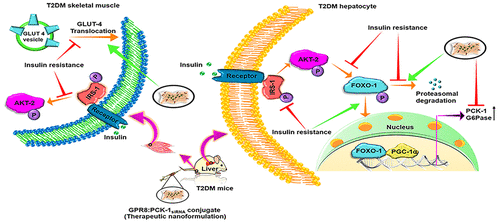当前位置:
X-MOL 学术
›
Bioconjugate Chem.
›
论文详情
Our official English website, www.x-mol.net, welcomes your feedback! (Note: you will need to create a separate account there.)
Liver Phosphoenolpyruvate Carboxykinase-1 Downregulation via siRNA-Functionalized Graphene Oxide Nanosheets Restores Glucose Homeostasis in a Type 2 Diabetes Mellitus In Vivo Model
Bioconjugate Chemistry ( IF 4.7 ) Pub Date : 2020-12-21 , DOI: 10.1021/acs.bioconjchem.0c00645 Vishal Singh 1, 2 , Poonam Sagar 1 , Sunaina Kaul 1 , Rajat Sandhir 2 , Nitin Kumar Singhal 1
Bioconjugate Chemistry ( IF 4.7 ) Pub Date : 2020-12-21 , DOI: 10.1021/acs.bioconjchem.0c00645 Vishal Singh 1, 2 , Poonam Sagar 1 , Sunaina Kaul 1 , Rajat Sandhir 2 , Nitin Kumar Singhal 1
Affiliation

|
Metabolic disorders have been increasing at an alarming rate, and one such example of metabolic disorder is type 2 diabetes mellitus (T2DM). Unregulated gluconeogenesis in T2DM results in increased hepatic glucose output that causes fasting and postprandial hyperglycaemia. Extensive proofs have shown that the downregulation of the key rate-limiting enzyme phosphoenolpyruvate carboxykinase-1 (PCK-1) of gluconeogenesis improved glucose homeostasis in vivo. In the present study, we have synthesized and characterized liver-specific stearic acid conjugated octaarginine (StA-R8) functionalized 4arm-2K-PEGamineylated graphene oxide nanosheets (GPR8) for the delivery of siRNA against PCK-1 in T2DM C57BL/6 mice. We found that a single intravenous administration of siRNA (3 mg/kg BW) conjugated to GPR8 (GPR8:PCK-1siRNA(3 mg/kg BW) conjugate) in an optimized N/P ratio exploited as a therapeutic nanoformulation maintained glucose homeostasis for nearly 4 weeks in the T2DM mice. Efficient silencing of PCK-1 in T2DM liver tissue increased the phosphorylation of serine-256 of FOXO-1, thus showing a marked decrease in hepatic gluconeogenesis. Gluconeogenesis control and consequently glucose output from the liver furthermore partially enhanced liver and muscle insulin sensitivity results in the stimulation of the insulin/AKT-2 signaling pathway which indirectly restored glucose homeostasis in the treated T2DM group. Our therapeutic nanoformulation also improved glycogen storage in the liver and membrane translocation of GLUT4 in the muscle of the treated T2DM group. In conclusion, GPR8:PCK-1siRNA (3 mg/Kg BW) restored glucose homeostasis by controlling the hepatic glucose production and improved peripheral insulin sensitivity as a consequence of reduced hyperglycemia. Thus, the current approach offered an alternative strategy for the therapeutics for T2DM.
中文翻译:

通过 siRNA 功能化氧化石墨烯纳米片下调肝磷酸烯醇式丙酮酸羧激酶-1,在 2 型糖尿病体内模型中恢复葡萄糖稳态
代谢紊乱一直以惊人的速度增加,代谢紊乱的一个例子是 2 型糖尿病 (T2DM)。T2DM 中不受调节的糖异生导致肝脏葡萄糖输出增加,从而导致空腹和餐后高血糖。大量证据表明,糖异生的关键限速酶磷酸烯醇丙酮酸羧激酶-1 (PCK-1) 的下调可改善体内葡萄糖稳态。在本研究中,我们合成并表征了肝脏特异性硬脂酸共轭八精氨酸 (StA-R8) 功能化的 4arm-2K-PEG 胺化氧化石墨烯纳米片 (GPR8),用于在 T2DM C57BL/6 小鼠中递送针对 PCK-1 的 siRNA。我们发现,单次静脉注射与 GPR8 (GPR8:PCK-1siRNA(3 mg/kg BW)偶联物)以优化的 N/P 比作为治疗性纳米制剂在 T2DM 小鼠中维持近 4 周的葡萄糖稳态。T2DM 肝组织中 PCK-1 的有效沉默增加了 FOXO-1 丝氨酸 256 的磷酸化,从而显示肝糖异生显着减少。糖异生控制和因此肝脏的葡萄糖输出进一步部分增强了肝脏和肌肉胰岛素敏感性,从而刺激了胰岛素/AKT-2 信号通路,间接恢复了治疗的 T2DM 组的葡萄糖稳态。我们的治疗性纳米制剂还改善了肝脏中的糖原储存和治疗的 T2DM 组肌肉中 GLUT4 的膜易位。总之,GPR8:PCK-1 siRNA (3 mg/Kg BW)通过控制肝脏葡萄糖的产生来恢复葡萄糖稳态,并由于降低高血糖而改善外周胰岛素敏感性。因此,目前的方法为 T2DM 的治疗提供了一种替代策略。
更新日期:2021-02-17
中文翻译:

通过 siRNA 功能化氧化石墨烯纳米片下调肝磷酸烯醇式丙酮酸羧激酶-1,在 2 型糖尿病体内模型中恢复葡萄糖稳态
代谢紊乱一直以惊人的速度增加,代谢紊乱的一个例子是 2 型糖尿病 (T2DM)。T2DM 中不受调节的糖异生导致肝脏葡萄糖输出增加,从而导致空腹和餐后高血糖。大量证据表明,糖异生的关键限速酶磷酸烯醇丙酮酸羧激酶-1 (PCK-1) 的下调可改善体内葡萄糖稳态。在本研究中,我们合成并表征了肝脏特异性硬脂酸共轭八精氨酸 (StA-R8) 功能化的 4arm-2K-PEG 胺化氧化石墨烯纳米片 (GPR8),用于在 T2DM C57BL/6 小鼠中递送针对 PCK-1 的 siRNA。我们发现,单次静脉注射与 GPR8 (GPR8:PCK-1siRNA(3 mg/kg BW)偶联物)以优化的 N/P 比作为治疗性纳米制剂在 T2DM 小鼠中维持近 4 周的葡萄糖稳态。T2DM 肝组织中 PCK-1 的有效沉默增加了 FOXO-1 丝氨酸 256 的磷酸化,从而显示肝糖异生显着减少。糖异生控制和因此肝脏的葡萄糖输出进一步部分增强了肝脏和肌肉胰岛素敏感性,从而刺激了胰岛素/AKT-2 信号通路,间接恢复了治疗的 T2DM 组的葡萄糖稳态。我们的治疗性纳米制剂还改善了肝脏中的糖原储存和治疗的 T2DM 组肌肉中 GLUT4 的膜易位。总之,GPR8:PCK-1 siRNA (3 mg/Kg BW)通过控制肝脏葡萄糖的产生来恢复葡萄糖稳态,并由于降低高血糖而改善外周胰岛素敏感性。因此,目前的方法为 T2DM 的治疗提供了一种替代策略。


























 京公网安备 11010802027423号
京公网安备 11010802027423号